Why would people use aerial photographs?
Why would people use aerial photographs?
In today's digital age, where high-resolution satellite imagery is readily available, one might wonder why people still utilize aerial photographs. However, aerial photography continues to play a crucial role in various fields and industries. From urban planning to environmental assessment, let's explore the reasons behind the continued use of aerial photographs.
1. Urban Planning and Development.

Aerial photographs provide valuable insights for urban planners and developers. By capturing images from a bird's-eye view, aerial photography offers a comprehensive overview of a specific area. This perspective allows professionals to assess the existing infrastructure, identify potential development opportunities, and plan the placement of new buildings and amenities. Moreover, comparing aerial photographs taken at different times can help monitor urban growth and evaluate the effectiveness of previous development projects.
2. Environmental Monitoring and Conservation.
Aerial photography is instrumental in environmental monitoring and conservation efforts. It enables scientists and researchers to study various aspects of our planet, such as deforestation, land use, and water resources. By analyzing aerial photographs, experts can monitor changes in ecosystems, track erosion and pollution patterns, and identify areas at risk of environmental degradation. This information is crucial for designing conservation strategies and implementing measures to safeguard our natural resources.
3. Archaeological Research.
The use of aerial photographs has revolutionized archaeological research. By capturing detailed images from above, archaeologists can identify features and patterns that are often invisible from ground level. Aerial photography helps in discovering ancient ruins, buried structures, and even previously unknown archaeological sites. These photographs allow researchers to map out landscapes, trace ancient trade routes, and gain a better understanding of historical civilizations. Consequently, aerial photography has significantly contributed to expanding our knowledge of human history.
4. Emergency Response and Disaster Management.
In times of natural disasters or emergencies, aerial photography proves invaluable for emergency response teams and disaster management agencies. Aerial photographs provide an immediate and comprehensive overview of the affected areas, allowing authorities to assess damage, plan rescue missions, and allocate resources more efficiently. Furthermore, these images facilitate better coordination among response teams and support the development of evacuation plans and strategies.
5. Real Estate and Property Assessment.
Aerial photography is widely used in the real estate industry and property assessment. Images captured from above offer a unique perspective for assessing property conditions, determining land values, and identifying potential issues such as soil erosion or flooding risks. Additionally, these photographs provide developers and investors with valuable information for site selection and market analysis.
6. Film and Entertainment Industry.
Aerial photography has become an essential tool in the film and entertainment industry. Capturing breathtaking aerial shots can add an entirely new dimension to movies, documentaries, and commercials. Moreover, these shots help create a sense of scale and grandeur, immersing the audience in stunning landscapes and cityscapes.
7. Cartography and Geographic Information Systems (GIS).
Aerial photographs are vital for creating accurate maps and aiding in Geographic Information Systems (GIS). The detailed images captured from above serve as an essential reference for surveyors, cartographers, and GIS professionals. By using aerial photographs to develop precise maps and overlay various layers of data, experts can analyze and interpret various spatial patterns and relationships.
In conclusion, aerial photography continues to be widely used in numerous fields and industries due to its unique advantages and applications. From urban planning and environmental monitoring to archaeological research and emergency response, aerial photographs provide a valuable perspective and offer insights that cannot be achieved through other means. As technology continues to advance, aerial photography will likely evolve further, becoming even more sophisticated and integral to various disciplines.
If you are looking for more details, kindly visit Railway Stations Aerial Working Platform, Self-Propelled Mobile Aerial Platform, Self-propelled Double Mast Aerial Working Platform.

Comments
0